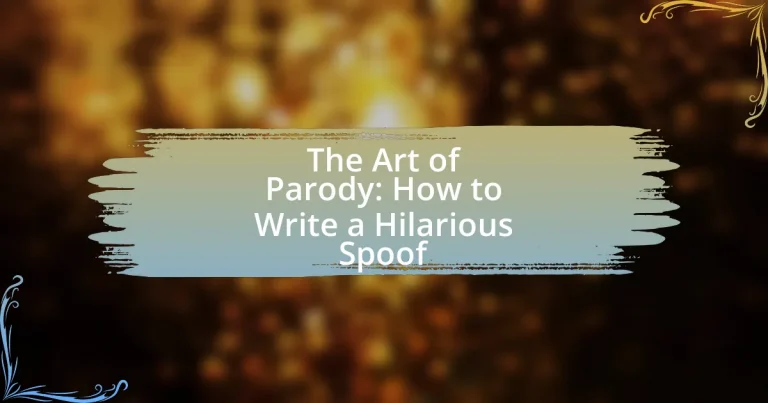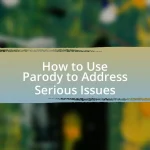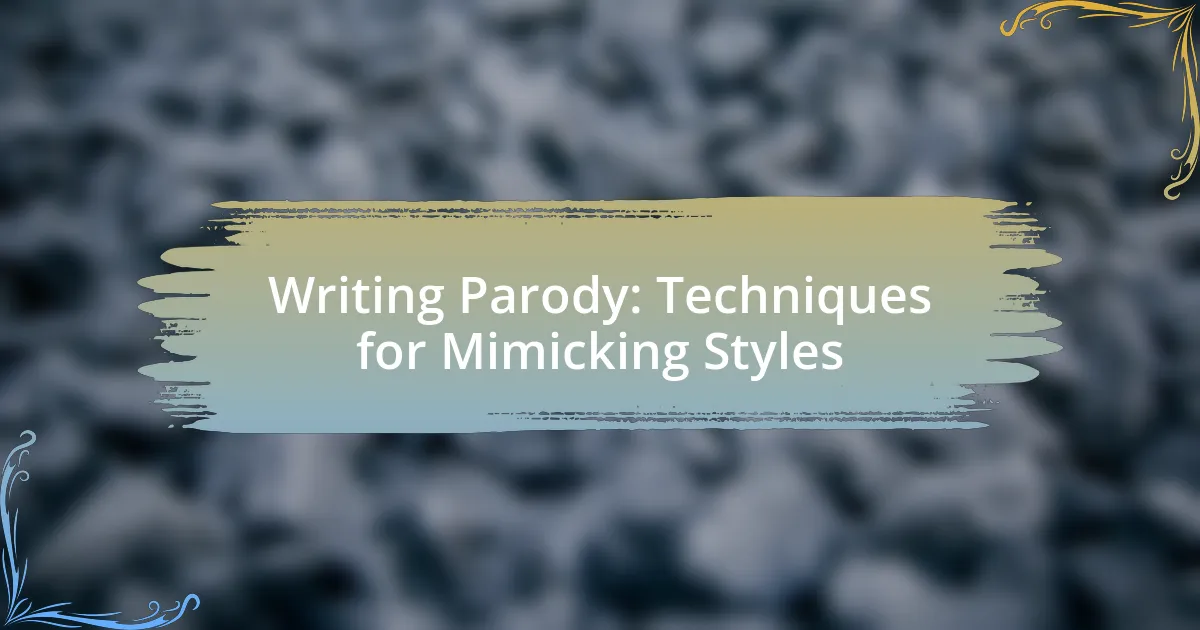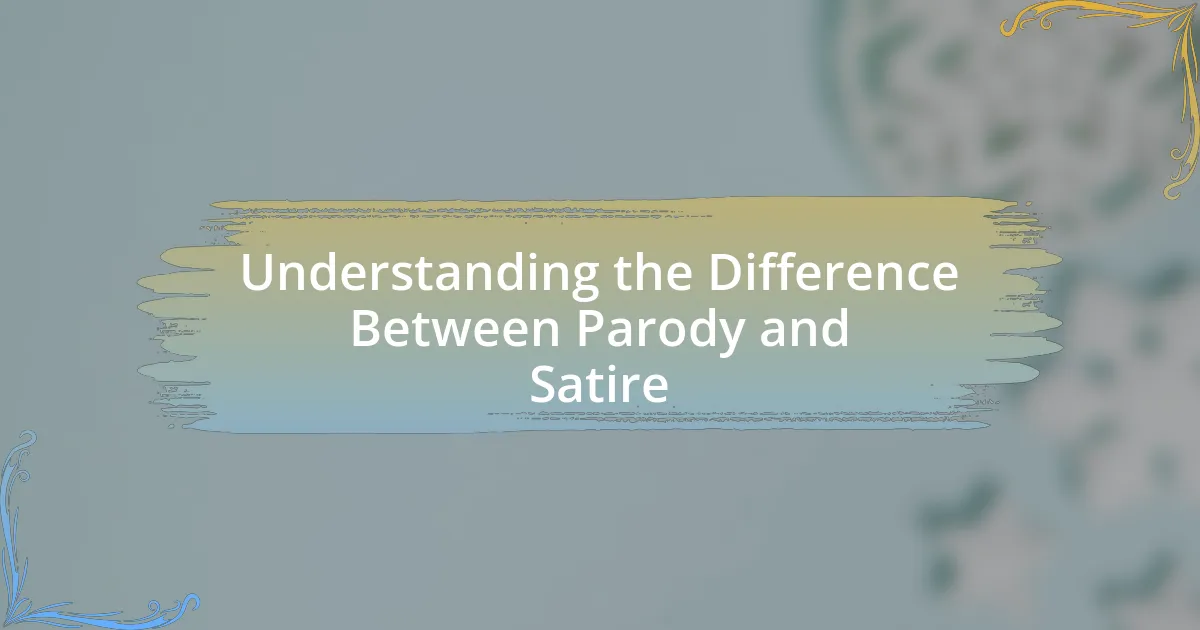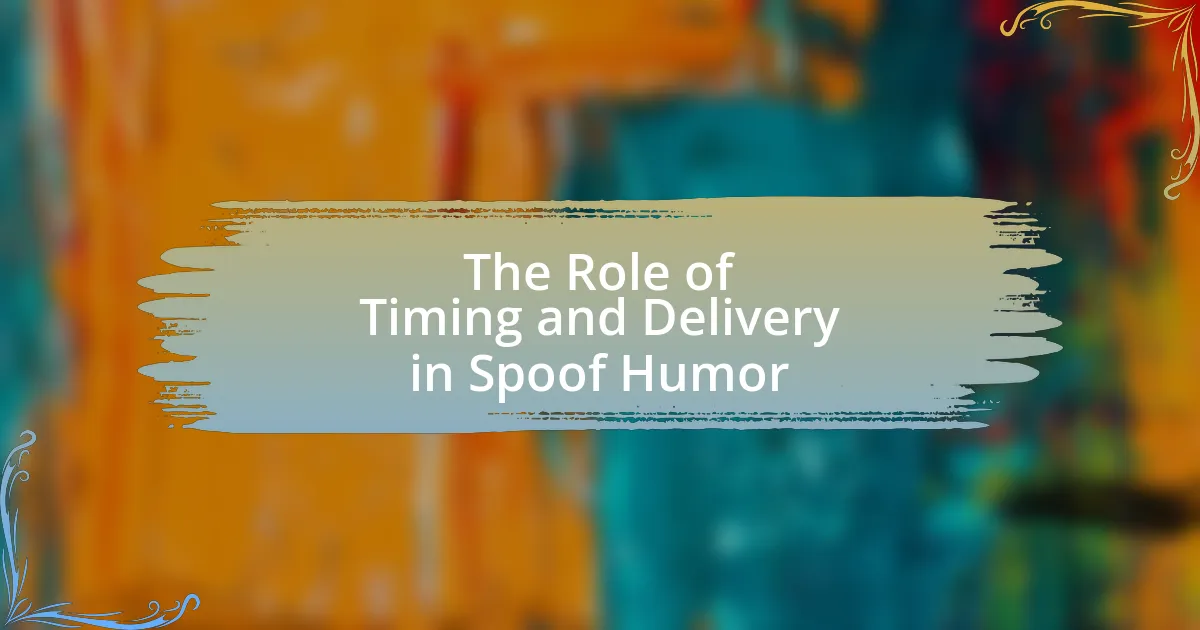The article “The Art of Parody: How to Write a Hilarious Spoof” explores the creative form of parody, which imitates and exaggerates original works to produce humor and critique. It outlines the differences between parody and other humor forms, key elements of successful parodies, and the importance of context and audience familiarity. Historical roots of parody are traced from ancient Greece to contemporary media, while practical guidance is provided on selecting subjects, analyzing targets, and employing writing techniques to enhance comedic effect. The article also addresses common pitfalls and best practices for refining parodies to ensure they are engaging and respectful.
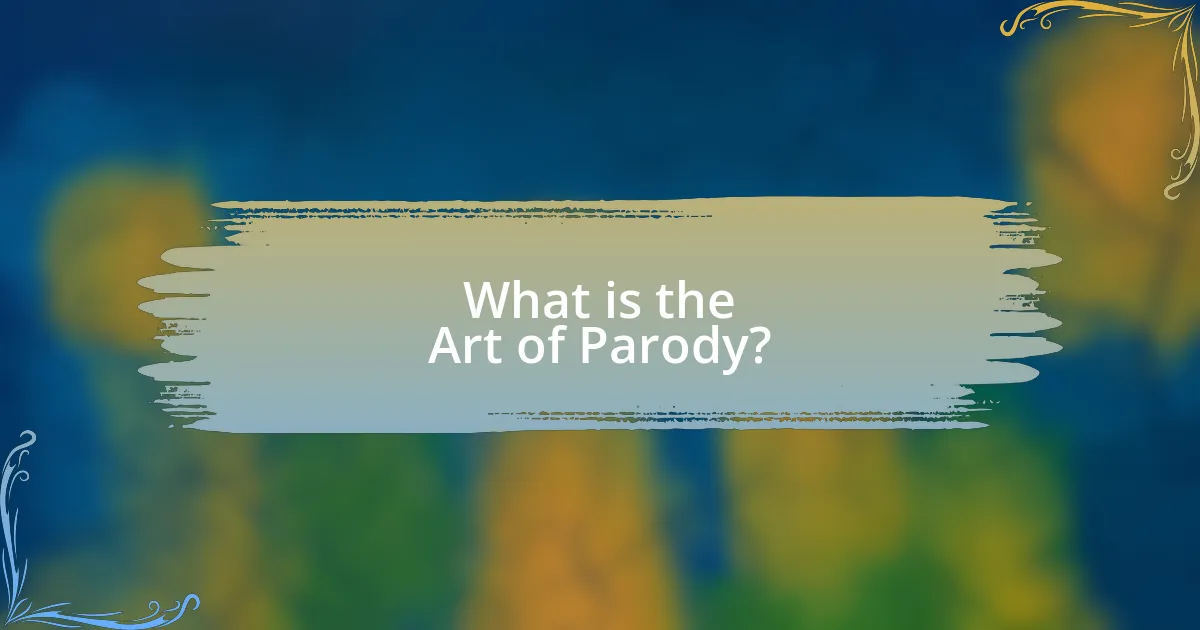
What is the Art of Parody?
The art of parody is a creative form of expression that imitates and exaggerates the style or content of a particular work, genre, or artist to produce a humorous or satirical effect. Parody often highlights the original’s flaws or absurdities, making it a tool for critique and entertainment. Historical examples include works like “Don Quixote” by Miguel de Cervantes, which parodies chivalric romances, and “The Simpsons,” which parodies various aspects of American culture. These examples demonstrate how parody can serve both as a form of entertainment and a means of social commentary.
How does parody differ from other forms of humor?
Parody differs from other forms of humor by specifically imitating and exaggerating the style or content of a particular work or genre to create comedic effect. Unlike general humor, which can rely on various techniques such as wordplay, absurdity, or observational comedy, parody focuses on a recognizable source, often critiquing or satirizing it. For example, works like “Weird Al” Yankovic’s song parodies directly reference and transform popular songs, highlighting their quirks while providing humor through imitation. This targeted approach distinguishes parody from broader comedic styles that may not engage with specific cultural artifacts.
What are the key elements that define a successful parody?
A successful parody is defined by its ability to mimic the style and content of the original work while incorporating humor and satire. Key elements include exaggeration, which amplifies the traits of the original to create comedic effect; cultural relevance, ensuring the parody resonates with contemporary audiences; and clever wordplay or dialogue that highlights the absurdities of the original. Additionally, a successful parody often includes a clear understanding of the source material, allowing for insightful commentary that enhances the humor. For instance, “Weird Al” Yankovic’s song parodies exemplify these elements by transforming popular songs into humorous takes that reflect societal issues, demonstrating the effectiveness of parody in both entertainment and critique.
Why is context important in creating effective parodies?
Context is crucial in creating effective parodies because it shapes the audience’s understanding and appreciation of the humor. Parodies rely on the recognition of the original work, and without context, the intended satire may be lost. For instance, a parody of a popular film or song will resonate more with audiences who are familiar with the source material, as they can appreciate the nuances and exaggerations that highlight the original’s flaws or tropes. Historical and cultural references also enhance the parody’s relevance, making it more impactful and relatable. Therefore, context not only informs the audience but also amplifies the comedic effect by providing a framework for interpretation.
What are the historical roots of parody?
The historical roots of parody can be traced back to ancient Greece, particularly in the works of playwrights like Aristophanes, who used comedic imitation to critique societal norms and political figures. This form of satire evolved through the Roman era, where poets such as Horace and Juvenal employed parody to mock contemporary literature and moral failings. The Renaissance further expanded parody’s scope, as writers like Rabelais and Cervantes utilized it to challenge established literary conventions. By the 18th century, parody became a prominent literary device in English literature, exemplified by works from authors like Alexander Pope, who parodied epic poetry to highlight its absurdities. These historical examples illustrate how parody has consistently served as a tool for social commentary and artistic expression throughout history.
How has parody evolved over time?
Parody has evolved from its early roots in ancient literature to a diverse and multifaceted form of expression in contemporary culture. Initially, parody served as a means to critique and mimic established works, as seen in the satirical writings of Aristophanes in ancient Greece, which targeted societal norms and political figures. Over time, during the Renaissance, parody became more structured, with authors like Cervantes using it to comment on literary conventions, exemplified in “Don Quixote,” which parodied chivalric romances.
In the 20th century, parody expanded into various media, including film and television, with shows like “Saturday Night Live” and movies like “Airplane!” showcasing its ability to blend humor with social commentary. The rise of the internet further transformed parody, allowing for rapid dissemination and remixing of content, as seen in viral videos and memes that often parody popular culture and current events. This evolution reflects a shift from a focus on literary critique to a broader engagement with media and societal issues, demonstrating parody’s adaptability and relevance in contemporary discourse.
What are some classic examples of parody in literature and film?
Classic examples of parody in literature and film include “Don Quixote” by Miguel de Cervantes, which parodies chivalric romances, and the film “Airplane!” directed by Jim Abrahams and the Zucker brothers, which parodies disaster films. “Don Quixote” uses humor to critique the absurdity of its genre, while “Airplane!” employs slapstick and absurdity to mock the conventions of serious cinema. These works exemplify how parody can effectively highlight and satirize the tropes of their respective genres.
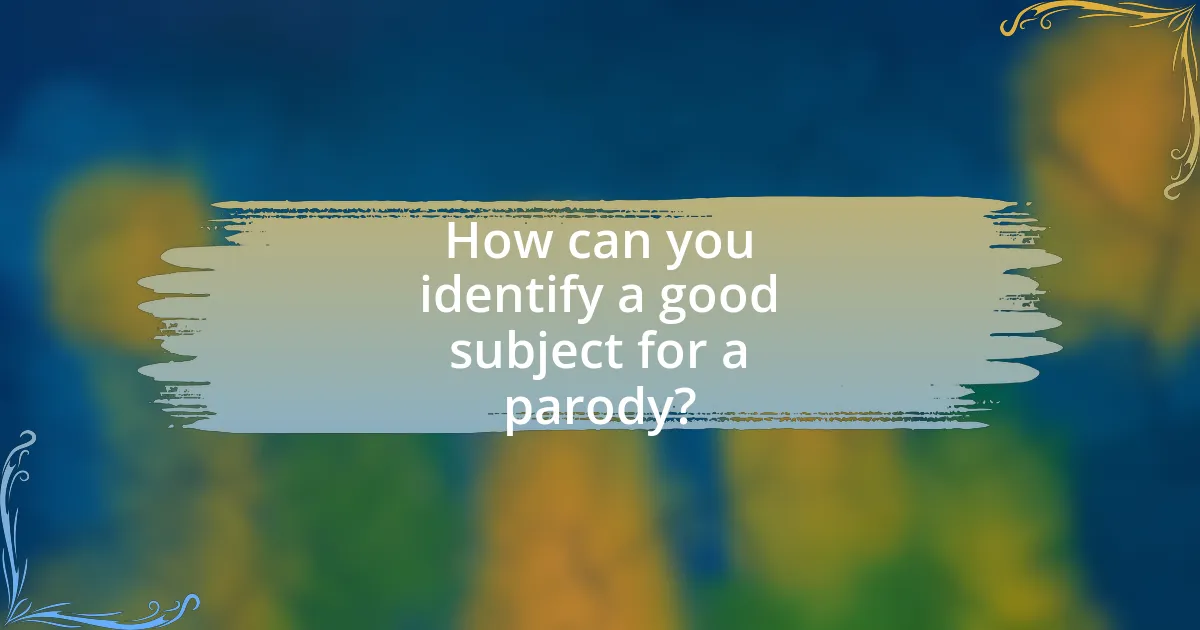
How can you identify a good subject for a parody?
A good subject for a parody can be identified by its cultural relevance and the potential for humor through exaggeration or satire. Subjects that are widely recognized, such as popular movies, celebrities, or current events, often provide a rich ground for parody because they resonate with a large audience. For instance, the success of parodies like “Scary Movie” demonstrates how familiar tropes can be humorously twisted to create comedic effect. Additionally, subjects that evoke strong opinions or emotions, such as political figures or social issues, can also serve as effective parody material, as they allow for sharp commentary and wit.
What criteria should you consider when choosing a target for parody?
When choosing a target for parody, consider the target’s cultural relevance and recognizability. A successful parody often relies on the audience’s familiarity with the subject, as this enhances the comedic effect. For instance, popular figures, current events, or widely known media can serve as effective targets because they resonate with a broad audience. Additionally, the target should possess characteristics that lend themselves to exaggeration or satire, allowing for humorous reinterpretation. Historical examples, such as “Saturday Night Live” parodies of political figures, demonstrate how recognizable targets can amplify comedic impact through shared cultural context.
How does cultural relevance influence your choice of subject?
Cultural relevance significantly influences the choice of subject in parody by ensuring that the content resonates with the audience’s experiences and societal context. When a subject is culturally relevant, it enhances relatability and humor, making the parody more impactful. For instance, parodies that reference current events or popular trends, such as the viral “Distracted Boyfriend” meme, engage audiences by tapping into shared cultural knowledge, thereby increasing the likelihood of the parody being well-received and understood. This connection to contemporary culture is crucial, as studies show that humor is often derived from shared experiences and societal norms, making culturally relevant subjects more effective in eliciting laughter and engagement.
What role does audience familiarity play in selecting a parody target?
Audience familiarity is crucial in selecting a parody target because it determines the effectiveness of the humor and the audience’s ability to recognize and appreciate the references. When the audience is well-acquainted with the original material, they can better understand the nuances and satire presented in the parody, leading to a more impactful comedic experience. For instance, parodies of popular films or well-known public figures resonate more with audiences who have prior knowledge of those subjects, as they can relate to the exaggerations and critiques being made. This connection enhances the overall reception and enjoyment of the parody, making audience familiarity a key factor in its success.
How can you analyze your target for effective parody?
To analyze your target for effective parody, identify the key characteristics, themes, and stylistic elements of the original work. This involves closely examining the content, tone, and cultural context of the source material to understand what makes it distinctive. For instance, if the target is a popular film, note its plot devices, character archetypes, and specific dialogue patterns. By dissecting these elements, you can create a parody that exaggerates or twists them for comedic effect. Research shows that successful parodies often rely on a deep understanding of the original, as evidenced by the popularity of works like “Scary Movie,” which effectively satirizes horror film tropes.
What techniques can help you break down the original work?
Techniques that can help you break down the original work include identifying key themes, analyzing character traits, and deconstructing plot structures. By pinpointing the central themes, you can understand the underlying messages and intentions of the original piece. Analyzing character traits allows you to exaggerate or satirize these characteristics effectively in your parody. Deconstructing plot structures helps in recognizing the narrative flow, enabling you to twist or subvert it for comedic effect. These techniques are essential for creating a successful and humorous spoof that resonates with the audience while maintaining a connection to the original work.
How can you identify the tropes and clichés to exaggerate?
To identify tropes and clichés to exaggerate, analyze popular media for recurring themes and character types. This involves examining films, books, and television shows to pinpoint common narrative devices, such as the “reluctant hero” or “love triangle.” Research indicates that these elements often evoke strong audience recognition, making them effective for parody. For instance, the “damsel in distress” trope is frequently exaggerated in comedic contexts to highlight its absurdity, as seen in various satirical films. By cataloging these familiar patterns, creators can effectively select which to amplify for comedic effect.
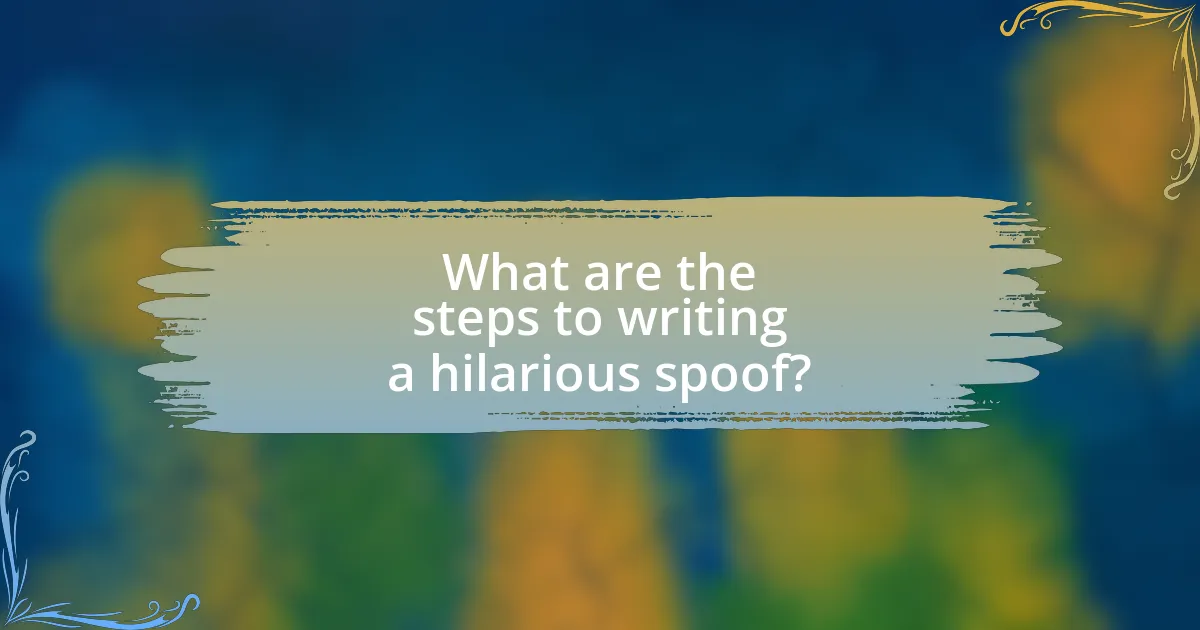
What are the steps to writing a hilarious spoof?
To write a hilarious spoof, follow these steps: first, select a target that is recognizable and has a strong cultural impact, such as a popular movie, book, or public figure. Next, analyze the original work to identify its key themes, tropes, and clichés. Then, exaggerate these elements for comedic effect, creating absurd scenarios that highlight their ridiculousness. After that, incorporate clever wordplay, puns, or satire to enhance the humor. Finally, revise and refine the spoof to ensure the pacing and punchlines are effective, aiming for a balance between humor and coherence. These steps are validated by successful parodists who have used similar techniques to create memorable and funny works.
How do you develop a unique voice for your parody?
To develop a unique voice for your parody, focus on identifying and exaggerating the distinctive traits of the original work while infusing your personal style. This involves analyzing the source material for its tone, themes, and character quirks, then amplifying these elements to create humor. For instance, if parodying a dramatic film, you might emphasize melodramatic dialogue and absurd scenarios to highlight the original’s seriousness. This method is supported by the concept of intertextuality, where the relationship between texts enhances meaning, as discussed in literary theory. By blending these techniques, you can craft a parody that resonates with audiences while maintaining originality.
What writing techniques can enhance comedic effect?
Writing techniques that can enhance comedic effect include the use of exaggeration, wordplay, and timing. Exaggeration amplifies characteristics or situations to absurd levels, making them humorous; for example, a character who is overly dramatic about minor inconveniences can create comedic tension. Wordplay, such as puns or malapropisms, adds a layer of cleverness that can surprise the audience and elicit laughter. Timing, particularly in the delivery of punchlines or the pacing of jokes, is crucial; a well-timed pause can heighten anticipation and enhance the impact of the humor. These techniques are widely recognized in comedic writing, as evidenced by the success of various comedic works that employ them effectively.
How can you incorporate satire into your parody?
To incorporate satire into your parody, focus on exaggerating the flaws or absurdities of the original subject while maintaining a humorous tone. This technique allows you to critique societal norms, behaviors, or cultural phenomena effectively. For example, in “The Onion,” a satirical news outlet, the writers often take real news stories and amplify their ridiculous aspects, highlighting the underlying truths about society. This method not only entertains but also provokes thought, making the parody resonate more deeply with the audience.
What structural elements should you include in your parody?
A parody should include structural elements such as exaggeration, imitation, and humor. Exaggeration amplifies characteristics of the original work, making them more absurd and comedic. Imitation involves closely mimicking the style, tone, or format of the source material, which allows the audience to recognize the reference. Humor is essential, often achieved through clever wordplay, situational irony, or absurd scenarios that highlight the flaws or quirks of the original. These elements work together to create a recognizable and entertaining spoof that resonates with the audience.
How can you create a compelling narrative while maintaining humor?
To create a compelling narrative while maintaining humor, integrate relatable characters and situations that evoke laughter without undermining the story’s core. This approach ensures that humor enhances the narrative rather than distracts from it. For instance, using absurdity in character traits or dialogue can create comedic moments while still advancing the plot. Research indicates that humor can increase engagement and retention in storytelling, as seen in studies by the University of Southern California, which found that humorous narratives are more memorable and enjoyable for audiences.
What pacing techniques are effective in comedic writing?
Effective pacing techniques in comedic writing include timing, rhythm, and the strategic use of pauses. Timing ensures that jokes land at the right moment, while rhythm maintains a flow that keeps the audience engaged. Pauses can heighten anticipation and enhance punchlines, allowing the humor to resonate. Research indicates that well-timed delivery can increase the effectiveness of comedic material, as seen in studies on stand-up comedy where timing significantly impacts audience laughter rates.
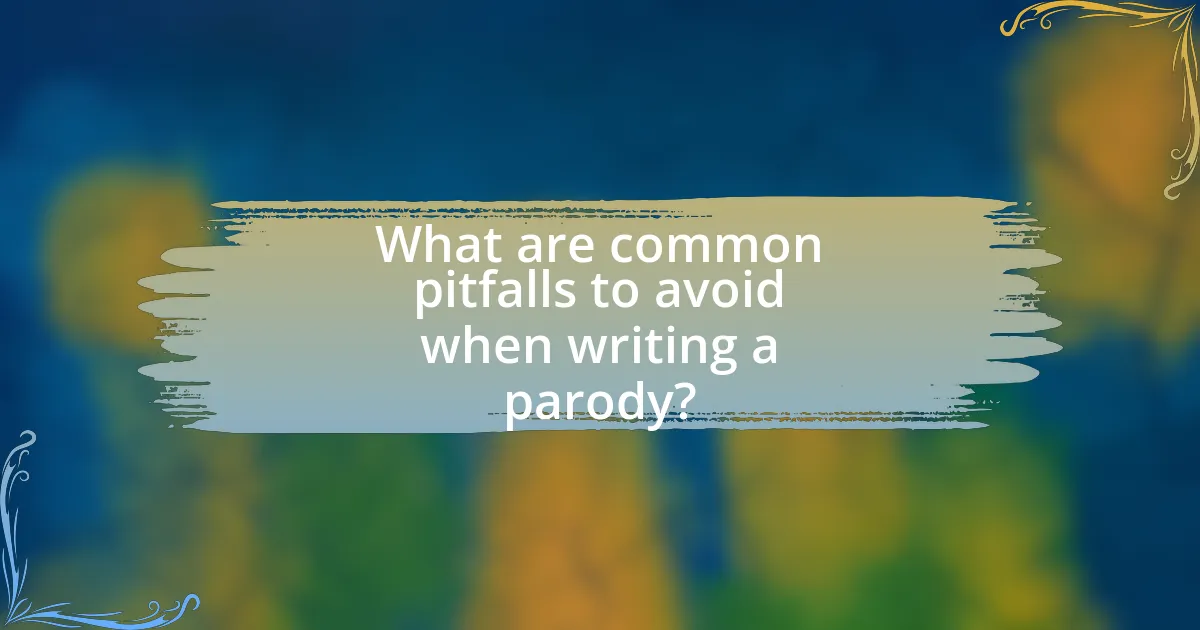
What are common pitfalls to avoid when writing a parody?
Common pitfalls to avoid when writing a parody include failing to understand the source material, which can lead to ineffective humor. Parody relies on a deep comprehension of the original work to create a humorous contrast; without this understanding, the parody may miss the mark. Additionally, excessive reliance on clichés can dilute the originality of the parody, making it predictable and less engaging. Another pitfall is neglecting the target audience, as humor can vary widely among different groups, and what is funny to one audience may not resonate with another. Lastly, being overly critical or mean-spirited towards the original work can alienate audiences, as successful parodies often celebrate the source material rather than simply mock it.
How can you ensure your parody is respectful and not offensive?
To ensure your parody is respectful and not offensive, focus on understanding the subject matter and the audience’s sensitivities. A respectful parody avoids targeting marginalized groups or reinforcing harmful stereotypes, instead opting for humor that critiques ideas or behaviors rather than individuals. Research indicates that successful parodies often rely on satire that highlights absurdities without demeaning specific people or communities, as seen in works by comedians like Jon Stewart and John Oliver, who use humor to address societal issues while maintaining respect for individuals.
What are the risks of relying too heavily on clichés?
Relying too heavily on clichés can lead to a lack of originality and creativity in writing. When writers depend on overused phrases, they risk making their work predictable and uninspired, which can disengage the audience. Research indicates that originality is a key factor in capturing and maintaining reader interest; for instance, a study published in the Journal of Creative Behavior found that unique expressions significantly enhance reader engagement compared to clichéd language. Additionally, excessive use of clichés can undermine the credibility of the writer, as it may suggest a lack of effort or depth in their work.
How can you avoid alienating your audience?
To avoid alienating your audience, ensure that your parody is relatable and respectful to the source material. By maintaining a balance between humor and sensitivity, you can engage your audience without offending them. Research indicates that successful parodies often resonate with audiences when they highlight shared experiences or cultural references, making the content more inclusive. For example, a study published in the Journal of Communication found that humor that aligns with audience values fosters connection rather than division.
What are some best practices for refining your parody?
To refine your parody effectively, focus on clarity, humor, and relevance. Clarity ensures that the audience understands the original work being parodied, while humor should be sharp and clever, often relying on exaggeration or absurdity to enhance comedic effect. Relevance involves connecting the parody to current events or cultural references, making it more relatable and engaging for the audience.
For instance, successful parodies like “Weird Al” Yankovic’s songs often highlight contemporary issues or popular culture, demonstrating how timely references can amplify humor. Additionally, testing your parody with a small audience can provide valuable feedback, allowing you to adjust elements that may not resonate as intended.
How can feedback improve your parody writing?
Feedback can significantly enhance parody writing by providing insights into audience perception and comedic effectiveness. When writers receive constructive criticism, they can identify which elements resonate with readers and which fall flat, allowing for targeted revisions. For instance, feedback can highlight areas where humor may be too subtle or references too obscure, enabling writers to adjust their content for clarity and impact. Studies in creative writing emphasize that peer reviews often lead to improved narrative structure and character development, which are crucial in parody to maintain engagement and humor. Thus, incorporating feedback not only refines the writing process but also elevates the overall quality of the parody.
What editing techniques can enhance the humor in your work?
Editing techniques that can enhance humor in your work include timing, pacing, and punch-up edits. Timing involves placing jokes or humorous elements at the right moment to maximize their impact, while pacing ensures that the rhythm of the narrative allows for comedic beats to land effectively. Punch-up edits focus on refining dialogue and descriptions to make them sharper and funnier, often by adding unexpected twists or wordplay. Research shows that well-timed humor can increase audience engagement, as demonstrated in studies on comedic timing in film and television, which highlight the importance of delivery in eliciting laughter.
What tips can help you create a successful parody?
To create a successful parody, focus on understanding the original work thoroughly, as this knowledge allows for effective satire. Analyze the themes, characters, and style of the source material to identify elements that can be exaggerated or subverted for comedic effect. Incorporating humor that resonates with the audience, such as cultural references or relatable situations, enhances the parody’s impact. Additionally, maintaining a balance between homage and critique ensures that the parody is both entertaining and insightful. Successful parodies often draw from well-known works, as familiarity increases audience engagement and appreciation.
